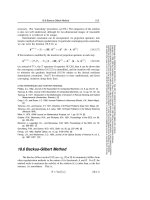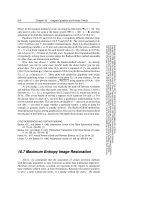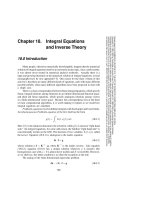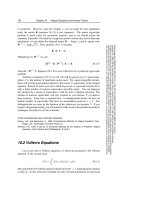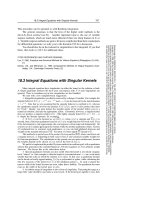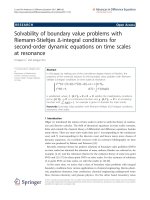Integral equations 2e sol abdul majid wazwaz
Bạn đang xem bản rút gọn của tài liệu. Xem và tải ngay bản đầy đủ của tài liệu tại đây (895.03 KB, 179 trang )
Second Edition
A FIRST COURSE
IN
INTEGRAL EQUATIONS
Solutions Manual
9571sc_9789814675154_tp.indd 1
13/2/15 9:42 am
b1816
MR SIA: FLY PAST
b1816_FM
This page intentionally left blank
www.pdfgrip.com
b1816_FM.indd vi
10/10/2014 1:12:39 PM
Second Edition
A FIRST COURSE
IN
INTEGRAL EQUATIONS
Solutions Manual
Abdul-Majid Wazwaz
Saint Xavier University, USA
World Scientific
NEW JERSEY
•
LONDON
•
SINGAPORE
•
BEIJING
•
SHANGHAI
•
HONG KONG
•
TA I P E I
•
CHENNAI
www.pdfgrip.com
9571sc_9789814675154_tp.indd 2
13/2/15 9:42 am
Published by
World Scientific Publishing Co. Pte. Ltd.
5 Toh Tuck Link, Singapore 596224
USA office: 27 Warren Street, Suite 401-402, Hackensack, NJ 07601
UK office: 57 Shelton Street, Covent Garden, London WC2H 9HE
Library of Congress Cataloging-in-Publication Data
Wazwaz, Abdul-Majid.
A first course in integral equations. Solutions manual / by Abdul-Majid Wazwaz (Saint Xavier
University, USA). -- Second edition.
pages cm
Includes bibliographical references and index.
ISBN 978-9814675154 (pbk. : alk. paper)
1. Integral equations--Problems, exercises, etc. I. Title.
QA431.W36 2015b
515'.45--dc23
2015008782
British Library Cataloguing-in-Publication Data
A catalogue record for this book is available from the British Library.
Copyright © 2015 by World Scientific Publishing Co. Pte. Ltd.
All rights reserved. This book, or parts thereof, may not be reproduced in any form or by any means,
electronic or mechanical, including photocopying, recording or any information storage and retrieval
system now known or to be invented, without written permission from the publisher.
For photocopying of material in this volume, please pay a copying fee through the Copyright Clearance
Center, Inc., 222 Rosewood Drive, Danvers, MA 01923, USA. In this case permission to photocopy
is not required from the publisher.
Printed in Singapore
www.pdfgrip.com
LaiFun - A First Course in Integral Equations.indd 1
8/4/2015 9:12:54 AM
March 4, 2015
14:44
book-9x6
THIS BOOK IS DEDICATED TO
My wife, our son, and our three daughters
for supporting me in all my endeavors
www.pdfgrip.com
9571-Root
page v
b1816
MR SIA: FLY PAST
b1816_FM
This page intentionally left blank
www.pdfgrip.com
b1816_FM.indd vi
10/10/2014 1:12:39 PM
March 4, 2015
14:44
book-9x6
9571-Root
Contents
Preface
ix
1 Introductory Concepts
1.2 Classification of Linear Integral Equations
1.3 Solution of an Integral Equation . . . . .
1.4 Converting Volterra Equation to an ODE
1.5 Converting IVP to Volterra Equation . . .
1.6 Converting BVP to Fredholm Equation .
1.7 Taylor Series . . . . . . . . . . . . . . . .
.
.
.
.
.
.
.
.
.
.
.
.
.
.
.
.
.
.
.
.
.
.
.
.
.
.
.
.
.
.
.
.
.
.
.
.
.
.
.
.
.
.
.
.
.
.
.
.
.
.
.
.
.
.
1
1
2
4
7
11
13
2 Fredholm Integral Equations
2.2 Adomian Decomposition Method . . . . . . .
2.3 The Variational Iteration Method . . . . . . .
2.4 The Direct Computation Method . . . . . . .
2.5 Successive Approximations Method . . . . . .
2.6 Successive Substitutions Method . . . . . . .
2.8 Homogeneous Fredholm Equation . . . . . . .
2.9 Fredholm Integral Equation of the First Kind
.
.
.
.
.
.
.
.
.
.
.
.
.
.
.
.
.
.
.
.
.
.
.
.
.
.
.
.
.
.
.
.
.
.
.
.
.
.
.
.
.
.
.
.
.
.
.
.
.
.
.
.
.
.
.
.
15
15
22
25
29
33
35
39
3 Volterra Integral Equations
3.2 Adomian Decomposition Method . .
3.3 The Variational Iteration Method . .
3.4 The Series Solution Method . . . . .
3.5 Converting Volterra Equation to IVP
3.6 Successive Approximations Method .
3.7 Successive Substitutions Method . .
3.9 Volterra Equations of the First Kind
.
.
.
.
.
.
.
.
.
.
.
.
.
.
.
.
.
.
.
.
.
.
.
.
.
.
.
.
.
.
.
.
.
.
.
.
.
.
.
.
.
.
.
.
.
.
.
.
.
.
.
.
.
.
.
.
41
41
54
57
63
67
75
79
.
.
.
.
.
.
.
vii
www.pdfgrip.com
.
.
.
.
.
.
.
.
.
.
.
.
.
.
.
.
.
.
.
.
.
.
.
.
.
.
.
.
.
.
.
.
.
.
page vii
March 4, 2015
14:44
book-9x6
9571-Root
viii
Contents
4 Fredholm Integro-Differential Equations
4.3 The Direct Computation Method . . . . . .
4.4 The Adomian Decomposition Method . . .
4.5 The Variational Iteration Method . . . . . .
4.6 Converting to Fredholm Integral Equations
.
.
.
.
.
.
.
.
.
.
.
.
85
85
90
94
96
5 Volterra Integro-Differential Equations
5.3 The Series Solution Method . . . . . . . . . .
5.4 The Adomian Decomposition Method . . . .
5.5 The Variational Iteration Method . . . . . . .
5.6 Converting to Volterra Equations . . . . . . .
5.7 Converting to Initial Value Problems . . . . .
5.8 The Volterra Integro-Differential Equations of
Kind . . . . . . . . . . . . . . . . . . . . . . .
. . . . . .
. . . . . .
. . . . . .
. . . . . .
. . . . . .
the First
. . . . . .
.
.
.
.
.
.
.
.
.
.
101
101
103
105
107
110
. . 113
6 Singular Integral Equations
6.2 Abel’s Problem . . . . . . . . . . . . . . .
6.3 Generalized Abel’s Problem . . . . . . . .
6.4 The Weakly Singular Volterra Equations .
6.5 The Weakly Singular Fredholm Equations
.
.
.
.
.
.
.
.
.
.
.
.
117
117
122
122
130
.
.
.
.
.
.
.
.
133
133
133
141
148
.
.
.
.
.
.
.
.
.
.
.
.
.
.
.
.
.
.
.
.
.
.
.
.
.
.
.
.
.
.
.
.
.
.
.
.
.
.
.
.
.
.
.
.
.
.
.
.
.
.
.
.
7 Nonlinear Fredholm Integral Equations
7.2 Nonlinear Fredholm Integral Equations . . . . . . . . . .
7.2.1 The Direct Computation Method . . . . . . . . .
7.2.2 The Adomian Decomposition Method . . . . . .
7.2.3 The Variational Iteration Method . . . . . . . . .
7.3 Nonlinear Fredholm Integral Equations of the First
Kind . . . . . . . . . . . . . . . . . . . . . . . . . . . . .
7.4 Weakly-Singular Nonlinear Fredholm Integral Equations
. . 149
. . 153
8 Nonlinear Volterra Integral Equations
8.2 Nonlinear Volterra Integral Equations . . . . . . . . . . . .
8.2.1 The Series Solution Method . . . . . . . . . . . . . .
8.2.2 The Adomian Decomposition Method . . . . . . . .
8.2.3 The Variational Iteration Method . . . . . . . . . . .
8.3 Nonlinear Volterra Integral Equations of the First Kind . .
8.3.1 The Series Solution Method . . . . . . . . . . . . . .
8.3.2 Conversion to a Volterra Equation of the Second
Kind . . . . . . . . . . . . . . . . . . . . . . . . . . .
8.4 Nonlinear Weakly-Singular Volterra Equation . . . . . . . .
www.pdfgrip.com
157
157
157
163
168
170
170
172
173
page viii
March 4, 2015
14:44
book-9x6
9571-Root
Preface
This Solutions Manual is provided as a supplement to accompany the text
A First Course in Integral Equations, Second Edition. It is intended:
• to develop readers’ skills for each linear or nonlinear exercise provided in
the textbook;
• to illustrate the use of the newly developed methods along with the traditional methods used in the text;
• to help readers master integral equations concepts so they can solve regular level and challenging exercises.
This Solutions Manual provides completely explained solutions to all
exercises of the textbook. The manual can be used by a wide variety of audience in various fields of mathematics, physics, chemistry and engineering.
Because the text A First Course in Integral Equations, Second Edition contains the newly developed methods and some of the classical methods, we
have aimed to make the Solutions Manual self-explanatory, instructional,
and useful. The fully-worked solutions are explained in a systematic way
focusing on the needs, suggestions and expectations of the readers. The
following distinguishing features make this Solutions Manual significant:
• it provides a fully worked solution for each problem in the text;
• it applies the new methods along with some of the classic methods for
most problems using the same strategies, notations, and terminologies used
in the text A First Course in Integral Equations, Second Edition;
• it illustrates the solutions in a systematic fashion consistent with the material presented in the text;
• it assists in helping readers gain knowledge and understanding of the
mathematical methods as they work through the problems and study the
solutions;
• it addresses all questions and suggestions made by students and scholars
who used the first edition;
• it complements the material and the worked examples of the textbook.
ix
www.pdfgrip.com
page ix
March 4, 2015
14:44
book-9x6
x
9571-Root
Preface
The text A First Course in Integral Equations, Second Edition presents
a variety of valuable methods and applications which cannot be found in
any other book. For this reason, and based upon a vast request by readers,
this Solutions Manual has been made to provide detailed explanations and
illustrations for solving each problem of the second edition.
I would like to acknowledge my wife for her genuine patience and I wish
to thank her for sincerely encouraging me in all my endeavors, including
the writing of the second edition of the textbook as well as the solutions
manual. I would also like to acknowledge our son and three daughters for
their support and encouragement.
Saint Xavier University
Chicago, IL 60655
Summer 2015
Abdul-Majid Wazwaz
e-mail:
www.pdfgrip.com
page x
March 4, 2015
14:44
book-9x6
9571-Root
Chapter 1
Introductory Concepts
1.2
Classification of Linear Integral Equations
Exercises
1.2
1. Fredholm, linear, nonhomogeneous
2. Volterra, linear, nonhomogeneous
3. Volterra, nonlinear, nonhomogeneous
4. Fredholm, linear, homogeneous
5. Fredholm, linear, nonhomogeneous
6. Fredholm, nonlinear, nonhomogeneous
7. Fredholm, nonlinear, nonhomogeneous
8. Fredholm, linear, nonhomogeneous
9. Volterra, nonlinear, nonhomogeneous
10. Volterra, linear, nonhomogeneous
11. Volterra integro-differential equation, nonlinear
12. Fredholm integro-differential equation, linear
13. Volterra integro-differential equation, nonlinear
14. Fredholm integro-differential equation, linear
15. Volterra integro-differential equation, linear
x
16. u(x) = 1 +
4u(t)dt
0
x
3t2 u(t)dt
17. u(x) = 1 +
0
x
u2 (t)dt
18. u(x) = 4 +
0
1
www.pdfgrip.com
page 1
March 12, 2015
12:19
book-9x6
2
9571-Root
Chapter 1. Introductory Concepts
x
4tu2 (t)dt, u(0) = 2
19. u (x) = 1 +
0
x
20. u (x) = 1 +
2tu(t)dt, u(0) = 0
0
21. Volterra–Fredholm integral equation, nonlinear, nonhomogeneous
22. Volterra–Fredholm integro-differential equation, linear, nonhomogeneous
23. Volterra–Fredholm integro-differential equation, nonlinear, nonhomogeneous
24. Volterra (singular) integral equation, nonlinear, nonhomogeneous
1.3
Solution of an Integral Equation
Exercises
1.3
1
1. Substituting u(x) = x + 24
in the right hand side yields
1
4
1
RHS = x +
t+
dt
24
0
= x + [ 12 t2 +
1
1
4
24 t]0
1
= x + 24
= u(x)
= LHS.
2. Substituting u(x) = x in the right hand side yields
1
xt2 dt
RHS = 23 x +
0
= 23 x + [ 13 xt3 ]10
= 23 x + 13 x
= u(x)
= LHS.
3. Substituting u(x) = 2x in the right hand side yields
1
4xt3 dt
RHS = x +
= x + [xt4 ]10
= 2x
= u(x)
= LHS
0
4. Substituting u(x) = sin x in the right hand side yields
www.pdfgrip.com
page 2
March 4, 2015
14:44
book-9x6
9571-Root
1.3. Solution of an Integral Equation
x
(x − t) sin tdt
RHS = x −
0
= x − [−x cos t − sin t + t cos t]x0
= sin x
= u(x)
= LHS.
5. Substituting u(x) = cosh x in the right hand side yields
x
RHS = 2 cosh x − x sinh x − 1 +
t cosh tdt
0
= 2 cosh x − x sinh x − 1 + [t sinh t − cosh t]x0
= cosh x
= u(x)
= LHS.
6. Substituting u(x) = x in the right hand side yields
x
RHS = x + 15 x5 −
= x + 15 x5 − [ 15 t5 ]x0
=x
= u(x)
= LHS.
t4 dt
0
7. Substituting u(x) = x2 in the right hand side yields
x
4t3 dt
RHS = 2x − x4 +
= 2x − x4 + [t4 ]x0
= 2x
= u (x)
= LHS.
0
8. Substituting u(x) = sin x in the right hand side yields
x
RHS = x cos x − 2 sin x +
t sin tdt
0
= x cos x − 2 sin x + [sin t − t cos t]x0
= − sin x
= u (x)
= LHS.
9. Substituting u(x) = 3 in the left hand side yields
x
2
3 (x − t) dt
LHS =
0
= [−(x − t)3 ]x0
www.pdfgrip.com
3
page 3
March 4, 2015
14:44
book-9x6
4
9571-Root
Chapter 1. Introductory Concepts
= x3
= RHS.
10. Substituting u(x) = 23 in the left hand side yields
x
1
3
(x − t) 2 dt
LHS =
0 2
3
= [−(x − t) 2 ]x0
3
= x2
= RHS.
11. Substituting u(x) = 2 cos x − 1 into both sides yields
x
(x − t)(2 cos t − 1)dt
2 cos x − 1 =
0
f (x) = x2
12. Substituting u(x) = ex into both sides yields
x
(x − t)(et )dt
ex = f (x)
0
f (x) = 1 + x
3
13. Substituting u(x) = e−x into both sides yields
x
3
3
3t2 (e−) dt,
e−x = 1 − α
0
α=1
14. Substituting u(x) = sin x into both sides yields
π
2
sin x = f (x) − 1
t sin t dt
0
f (x) = sin x
1.4
Converting Volterra Equation to an ODE
Exercises 1.4
x
3(x − t)2 u(t)dt
1.
0
2. 2xe
x3
x
x2
−e
x2
text dt
+
x
4(x − t)3 u(t)dt
3.
0
4x
4. 4 sin 5x − sin 2x +
cos(x + t)dt
x
www.pdfgrip.com
page 4
March 4, 2015
14:44
book-9x6
9571-Root
1.4. Converting Volterra Equation to an ODE
5
5. Differentiating both sides three times, we obtain
x
2(x − t)u(t)dt
u (x) = 1 +
0
x
u (x) =
2u(t)dt
0
u (x) = 2u(x)dt
Substituting x = 0 in the original equation and the first two derivatives,
we find u(0) = u (0) = 1, u (0) = 0
Hence, the equivalent initial value problem is
u (x) = 2u(x), u(0) = u (0) = 1, u (0) = 0
6. Differentiating both sides two times, we obtain
x
u (x) = ex −
u(t)dt
0
u (x) = ex − u(x)
Substituting x = 0 in the original equation and the first derivative, we find
u(0) = u (0) = 1
Hence, the equivalent initial value problem is
u (x) + u(x) = ex , u(0) = u (0) = 1
7. Differentiating both sides two times, we obtain
x
u (x) = 1 +
u(t)dt
0
u (x) = u(x)
Substituting x = 0 in the original equation and the first derivative, we find
u(0) = 0, u (0) = 1
Hence, the equivalent initial value problem is
u (x) − u(x) = 0, u(0) = 0, u (0) = 1
8. Differentiating both sides two times, we obtain
x
u (x) = 1 + sin x +
u(t)dt
0
u (x) = cos x + u(x)
Substituting x = 0 in the original equation and the first derivative, we find
u(0) = −1, u (0) = 1
Hence, the equivalent initial value problem is
u (x) − u(x) = cos x, u(0) = −1, u (0) = 1
9. Differentiating both sides two times, we obtain
x
u (x) = 3 + 10x + u(x) +
2u(t)dt
0
u (x) = 10 + u (x) + 2u(x)
www.pdfgrip.com
page 5
March 4, 2015
14:44
book-9x6
9571-Root
6
Chapter 1. Introductory Concepts
Substituting x = 0 in the original equation and the first derivative, we find
u(0) = 2, u (0) = 5
Hence, the equivalent initial value problem is
u (x) − u (x) − 2u(x) = 10, u(0) = 2, u (0) = 5
10. Differentiating both sides two times, we obtain
x
u (x) = 6 + 5u(x) −
6u(t)dt
0
u (x) = 5u (x) − 6u(x)
Substituting x = 0 in the original equation and the first derivative, we find
u(0) = −5, u (0) = −19
Hence, the equivalent initial value problem is
u (x) − 5u (x) + 6u(x) = 0, u(0) = −5, u (0) = −19
11. Differentiating both sides we obtain
u (x) = sec2 x − u(x)
Substituting x = 0 in the original equation we find
u(0) = 0
Hence, the equivalent initial value problem is
u (x) + u(x) = sec2 x, u(0) = 0
12. Differentiating both sides three times, we obtain
x
[6 − 5(x − t)]u(t)dt
u (x) = 1 + 5x + 3u(x) +
0
x
u (x) = 5 + 3u (x) + 6u(x) − 5
u(t)dt
0
u (x) = 3u (x) + 6u (x) − 5u(x)
Substituting x = 0 in the original equation and the first two derivatives,
we find u(0) = 1, u (0) = 4, u (0) = 23
Hence, the equivalent initial value problem is
u (x) − 3u (x) − 6u (x) + 5u(x) = 0,
u(0) = 1, u (0) = 4, u (0) = 23
13. u (x) − 4u(x) = 24x,
u(0) = u (0) = 0, u (0) = 2
14. uiv (x) − u(x) = 0,
u(0) = u (0) = 0, u (0) = 2, u (0) = 0
www.pdfgrip.com
page 6
March 4, 2015
14:44
book-9x6
1.5. Converting IVP to Volterra Equation
1.5
Converting IVP to Volterra Equation
Exercises 1.5
1. We first set
y (x) = u(x)
Integrating both sides from 0 to x we find
x
y(x) − 1 = 0 u(t)dt
Substituting in the original equation we find
x
u(x) = −1 −
u(t)dt
0
2. We first set
y (x) = u(x)
Integrating both sides from 0 to x, we find
x
y(x) = 0 u(t)dt
Substituting in the original equation we find
x
u(x) = x +
u(t)dt
0
3. We first set
y (x) = u(x)
Integrating both sides from 0 to x we find
x
y(x) = 0 u(t)dt
Substituting in the original equation we find
x
u(x) = sec2 (x) −
u(t)dt
0
4. We first set
y (x) = u(x)
Integrating both sides from 0 to x twice gives
x
y (x) − y (0) = 0 u(t)dt
x x
y(x) − y(0) − xy (0) = 0 0 u(t)dtdt
or equivalently
x
y(x) = 1 + 0 (x − t)u(t)dt
Substituting in the original equation we find
x
u(x) = −1 −
(x − t)u(t)dt
0
5. We first set
y (x) = u(x)
Integrating both sides from 0 to x twice gives
x
y (x) − y (0) =
u(t)dt
0
www.pdfgrip.com
9571-Root
7
page 7
March 12, 2015
12:19
book-9x6
8
9571-Root
Chapter 1. Introductory Concepts
x
x
y(x) − y(0) − xy (0) =
u(t)dtdt
0
0
or equivalently
x
y(x) = 1 + x + 0 (x − t)u(t)dt
Substituting in the original equation we find
x
(x − t)u(t)dt
u(x) = 1 + x +
0
6. We first set
y (x) = u(x)
Integrating both sides from 0 to x twice gives
x
y (x) − y (0) =
u(t)dt
0
x
x
y(x) − y(0) − xy (0) =
u(t)dtdt
0
0
or equivalently
x
y(x) = 1 + x + 0 (x − t)u(t)dt
Substituting in the original equation we find
x
u(x) = −11 − 6x −
[5 + 6(x − t)] u(t)dt
1
7. We first set
y (x) = u(x)
Integrating both sides from 0 to x twice gives
x
y (x) − y (1) =
u(t)dt
1
or equivalently
x
y (x) = 1 + 1 u(t)dt
Substituting in the original equation we find
x
u(x) = −1 −
u(t)dt
1
8. We first set
y (x) = u(x)
Integrating both sides from 0 to x twice gives
x
y (x) − y (0) =
u(t)dt
0
x
x
y(x) − y(0) − xy (0) =
u(t)dtdt
0
0
or equivalently
x
y(x) = x + 0 (x − t)u(t)dt
Substituting in the original equation we find
x
u(x) = −1 + 4x +
[2(x − t) − 1] u(t)dt
0
www.pdfgrip.com
page 8
March 4, 2015
14:44
book-9x6
9571-Root
1.5. Converting IVP to Volterra Equation
9
9. We first set
y (x) = u(x)
Integrating both sides from 0 to x twice gives
x
y (x) − y (0) =
u(t)dt
0
x
x
y(x) − y(0) − xy (0) =
u(t)dtdt
0
0
or equivalently
x
y(x) = 0 (x − t)u(t)dt
Substituting in the original equation we find
x
u(x) = sin x −
(x − t)u(t)dt
0
10. We first set
y (x) = u(x)
Integrating both sides from 0 to x twice gives
x
y (x) − y (0) =
u(t)dt
0
x
x
y(x) − y(0) − xy (0) =
u(t)dtdt
0
0
or equivalently
x
y(x) = 1 − x + 0 (x − t)u(t)dt
Substituting in the original equation we find
x
u(x) = x − sin x + xex − ex −
[(x − t)ex − sin x] u(t)dt
0
11. We first set
y (x) = u(x)
Integrating both sides from 0 to x three times gives
x
y (x) − y (0) =
u(t)dt
0
x
x
y (x) − y (0) − xy (0) =
u(t)dtdt
0
0
y(x) − y(0) − xy (0) − 21 x2 y (0) =
x
x
x
u(t)dtdtdt
0
0
0
or equivalently
x
y(x) = 2 + x2 + 12 0 (x − t)2 u(t)dt
Substituting in the original equation we find
x
1
u(x) = 2x − x2 +
1 + (x − t) − (x − t)2 u(t)dt
2
0
12. We first set
y (x) = u(x)
Integrating both sides from 0 to x three times gives
www.pdfgrip.com
page 9
March 4, 2015
14:44
book-9x6
9571-Root
10
Chapter 1. Introductory Concepts
x
y (x) − y (0) =
u(t)dt
0
x
x
y (x) − y (0) − xy (0) =
u(t)dtdt
0
0
or equivalently
x
y (x) = x + 0 (x − t)u(t)dt
Substituting in the original equation we find
x
u(x) = −3x − 4
(x − t)u(t)dt
0
13. We first set
y iv (x) = u(x)
Integrating both sides from 0 to x three times gives
x
y (x) − y (0) =
u(t)dt
0
x
x
y (x) − y (0) − xy (0) =
u(t)dtdt
0
0
x
y (x) − y (0) − xy (0) − 12 x2 y (0) =
x
x
u(t)dtdtdt
0
0
0
x
y(x) − y(0) − xy (0) − 21 x2 y (0) − 16 x3 y (0) =
x
x
x
u(t)dtdtdtdt
0
0
0
0
and by changing multiple integrals to single integrals and by substituting
in the original equation we find
x
1
1
1
2(x − t) + (x − t)3 u(t)dt
u(x) = 2 + x − x2 − x3 −
2
6
6
0
14. We first set
y iv (x) = u(x)
Integrating both sides from 0 to x three times gives
x
y (x) − y (0) =
u(t)dt
0
x
x
y (x) − y (0) − xy (0) =
u(t)dtdt
0
0
y (x) − y (0) − xy (0) − 12 x2 y (0) =
x
x
x
u(t)dtdtdt
0
0
0
y(x) − y(0) − xy (0) − 21 x2 y (0) − 16 x3 y (0) =
x
x
x
x
u(t)dtdtdtdt
0
0
0
0
and by changing multiple integrals to single integrals and by substituting
in the original equation we find
1 x
1
(x − t)3 u(t)dt
u(x) = 1 − x2 +
2
3! 0
15. We first set
y iv (x) = u(x)
www.pdfgrip.com
page 10
March 12, 2015
12:19
book-9x6
9571-Root
1.6. Converting BVP to Fredholm Equation
11
Integrating both sides from 0 to x three times gives
x
y (x) − y (0) =
u(t)dt
0
x
x
y (x) − y (0) − xy (0) =
u(t)dtdt
0
0
x
x
x
y (x) − y (0) − xy (0) − 12 x2 y (0) =
u(t)dtdtdt
0
0
0
y(x) − y(0) − xy (0) − 21 x2 y (0) − 16 x3 y (0) =
x
x
x
x
u(t)dtdtdtdt
0
0
0
0
and by changing multiple integrals to single integrals and by substituting
in the original equation we find
x
u(x) = 2ex − 1 − x −
(x − t)u(t)dt
0
1.6
Converting BVP to Fredholm Equation
Exercises
1.6
1. We first set
y (x) = u(x)
Integrating both sides from 0 to x twice we find
x
y (x) = y (0) + 0 u(t)dt
x
y(x) = y(0) + xy (0) + 0 (x − t)u(t)dt
Substituting x = 1 in the last equation and using the boundary condition
at x = 1 gives
1
y (0) = − 0 (1 − t)u(t)dt
Accordingly, we obtain
1
x
y(x) = −x 0 (1 − t)u(t)dt + 0 (x − t)u(t)dt
Substituting in the original equation, we obtain
x
1
x
u(x) = sin x + 4x 0 (1 − t)u(t)dt + 4x x (1 − t)u(t)dt − 4 0 (x − t)u(t)dt
This gives
1
u(x) = sin x +
K(x, t)u(t)dt
0
K(x, t) =
4t(1 − x)
4x(1 − t)
0≤t≤x
x≤t≤1
2. We first set
y (x) = u(x)
Integrating both sides from 0 to x twice we find
x
y (x) = y (0) + 0 u(t)dt
x
y(x) = y(0) + xy (0) + 0 (x − t)u(t)dt
Substituting x = 1 in the last equation and using the boundary condition
www.pdfgrip.com
page 11
March 4, 2015
14:44
book-9x6
9571-Root
12
Chapter 1. Introductory Concepts
at x = 1 we obtain
1
y (0) = − 0 (1 − t)u(t)dt
Accordingly, we obtain
1
x
y(x) = −x 0 (1 − t)u(t)dt + 0 (x − t)u(t)dt
Substituting in the original equation, we obtain
x
1
u(x) = 1 + 2x2 0 (1 − t)u(t)dt + 2x2 x (1 − t)u(t)dt − 2x
This gives
x
(x
0
− t)u(t)dt
1
u(x) = 1 +
K(x, t)u(t)dt,
0
K(x, t) =
2xt(1 − x)
2x2 (1 − t)
0≤t≤x
x≤t≤1
3. We first set
y (x) = u(x)
Integrating both sides from 0 to x twice we find
x
y (x) = y (0) + 0 u(t)dt
x
y(x) = y(0) + xy (0) + 0 (x − t)u(t)dt
Substituting x = 1 in the last equation and using the boundary condition
at x = 1 we obtain
1
y (0) = −1 − 0 (1 − t)u(t)dt
Accordingly, we obtain
1
x
y(x) = 1 − x − x 0 (1 − t)u(t)dt + 0 (x − t)u(t)dt
Substituting in the original equation, we obtain
x
1
x
u(x) = (2x − 1) + x 0 (1 − t)u(t)dt + x x (1 − t)u(t)dt + 0 (x − t)u(t)dt
This gives
1
u(x) = (2x − 1) +
K(x, t)u(t)dt,
0
K(x, t) =
t(1 − x)
x(1 − t)
0≤t≤x
x≤t≤1
4. We first set
y (x) = u(x)
Integrating both sides from 0 to x twice we find
x
y (x) = y (0) + 0 u(t)dt
x
y(x) = y(0) + xy (0) + 0 (x − t)u(t)dt
Substituting x = 1 in the first equation and using the boundary condition
x = 1 we obtain
1
y (0) = − 0 (1 − t)u(t)dt
Accordingly, we obtain
1
x
y(x) = 1 − x 0 u(t)dt + 0 (x − t)u(t)dt
Substituting in the original equation, we obtain
x
x
1
u(x) = x − 1 + x 0 u(t)dt + x x u(t)dt − 0 (x − t)u(t)dt
www.pdfgrip.com
page 12
March 4, 2015
14:44
book-9x6
1.7. Taylor Series
13
1
This gives u(x) = (x − 1) +
K(x, t)u(t)dt,
0
K(x, t) =
1.7
t
x
0≤t≤x
x≤t≤1
Taylor Series
Exercises
1.7
2x
1. f (x) = e
3. f (x) = ex − 1
5. f (x) = sin(3x)
7. f (x) = cosh(2x)
9. f (x) = 1 + cos(2x)
9571-Root
2. f (x) = e−3x
4. f (x) = cos(2x)
6. f (x) = sinh(2x)
8. f (x) = cosh(3x) − 1
10. f (x) = 1 + sin x
www.pdfgrip.com
page 13
March 4, 2015
14:44
book-9x6
9571-Root
Chapter 2
Fredholm Integral
Equations
2.2
Adomian Decomposition Method
Exercises
2.2
1. We set
13
u0 (x) =
x
3
Hence, we find
1 1 13 2
u1 (x) = −
xt dt
4 0 3
13
u1 (x) = −
x
3 × 12
and
13
u2 (x) =
x
3 × 144
and so on. Accordingly, we find
13
1
1
u(x) =
x 1−
+
+ ···
4
12 144
And by evaluating the infinite geometric series at the right hand side, we
find
u(x) = 4x
2. We set
1
u0 (x) = x3 − x
5
Hence, we find
15
www.pdfgrip.com
page 15
March 4, 2015
14:44
book-9x6
16
9571-Root
Chapter 2. Fredholm Integral Equations
1
u1 (x) =
0
1
2
x t4 − t2 dt =
x
5
15
and
2
u2 (x) =
x
45
and so on. Accordingly, we find
2
1 1
u(x) = x3 − 15 x + x 1 + + + · · ·
15
3 9
And by evaluating the infinite geometric series at the right hand side, we
find
u(x) = x3
3. We set
u0 (x) = x2
Hence, we find
1
xt3 dt =
u1 (x) =
0
1
x
4
and
1
u2 (x) =
x
12
and so on. Accordingly, we find
1
1 1
u(x) = x2 + x 1 + + + · · ·
4
3 9
And by evaluating the infinite geometric series at the right hand side, we
find
u(x) = x2 + 38 x
4. We set
u0 (x) = ex
Hence, we find
1
et dt
u1 (x) = e−1
0
−1
u1 (x) = 1 − e
and
u2 (x) = e−1 − e−2
u3 (x) = e−2 − e−3
and so on. Accordingly, we find
u(x) = ex + 1 − e−1 − e−1 + e−2 − e−2 + · · ·
u(x) = ex + 1
5. We set
u0 (x) = x + sin x
Hence, we find
www.pdfgrip.com
page 16
